2009 年 6 月英语六级真题(A 卷)
Part I Writing (30 minutes)
Directions:Forthispart,youareallowed30minutestowriteashortessayentitled
On the Importance of a Name. Youshouldwriteatleast150wordsfollowingtheoutline
given below.
1. 有人说名字或名称很重要
2. 也有人觉得名字或名称无关紧要
3. 我认为
On the Importance of a Name
Part II Reading Comprehension (Skimming and Scanning) (15 minutes)
Directions: In this part, youwill have 15 minutes to go over the passage quickly
andanswerthequestionsonAnswer Sheet 1. Forquestions1-7,choosethebestanswer
from the four choices marked A), B), C) and D). For questions 8-10, complete the
sentences with the information given in the passage.
Helicopter Moms vs. Free-Range Kids
Would you let your fourth-grader ride public transportation without an adult?
Probably not. Still, when Lenore Skenazy, a columnist for the New York Sun, wrote
about letting her son take the subway alone to get back to her Manhattan home from
a department store on the Upper East Side, she didn’t expect to get hit with a wave
of criticism from readers.
“Long story short: My son got home, overjoyed with independence,” Skenazy wrote
on April 4 in the NewYorkSun. “Long story longer: Half the people I’ve told this
episode to now want to turn on in for child abuse. As if keeping kids under lock
and key and cell phone and careful watch is the right way to rear kids. It’s not.
It’s debilitating (使虚弱)—for us and for them.”
Online message boards were soon full of people both applauding and condemning
Skenazy’s decision to let her son go it alone. She wound up defending herself on
CNN (accompanied by her son) and on popular blogs like the Buffington Post, where
her follow-up piece was ironically headlined “More From America’s Worst Mom.”
The episode has ignited another one of those debates that divides parents into vocal
opposing camps. Are Modern parents needlessly overprotective, or is the world a more
complicated and dangerous place than it was when previous generations were allowed
to wander about unsupervised?
From the “she’s an irresponsible mother” camp came: “Shame on you for being so
careless about his safety,” in Comments on the BuffingtonPost. And there was this
from a mother of four: “How would you have felt if he didn’t come home?” But Skenazy
got a lot of support, too, with women and men writing in with stories about how they
were allowed to take trips all by them selves at seven or eight. She also got heaps
of praise for bucking the “helicopter parent” trend: “Good for this Mom,” one
commenter wrote on the Buffington Post. “This is a much-needed reality check.”
Last week, encouraged by all the attention, Skenazy started her own blog—Free Range,
�
kids—promoting the idea that modern children need some of the same independence
that her generation had. In the good old days nine-year-old baby boomers rode their
bikes to school, walked to the store, took buses—and even subways—all by themselves.
Her blog, she says, is dedicated to sensible parenting. “At Free Range Kids, we
believe in safe kids. We believe in car seats and safety belts. We do NOT believe
that every time school-age children go outside, they need a security guard.”
So why are some parents so nervous about letting their children out of their sight?
Are cities and towns less safe and kids more vulnerable to crimes like child kidnap
and sexual abuse than they were in previous generations?
Not exactly. New York City, for instance, is safer than it’s ever been; it’s ranked
36th in crime among all American cities. Nationwide, stringer kidnaps are extremely
rare; there’s a one-in-a-million chance a child will be taken by a stranger,
according to the Justice Department. And 90 percent of sexual abuse cases are
committed by someone the child knows. Mortality rates from all causes, including
disease and accidents, for American children are lower now than they were 25 years’
ago. According to Child Trends, a nonprofit research group, between 1980 and 2003
death rates dropped by 44 percent for children aged 5 to 14 and 32 percent for teens
aged 15 to 19.
Then there’s the whole question of whether modern parents are more watchful and
nervous about safety than previous generations. Yes, some are. Part of the problem
is that with wall to wall Internet and cable news, every missing child case gets
so much airtime that it’s not surprising even normal parental anxiety can be
amplified. And many middle-class parents have gotten used to managing their
children’s time and shuttling them to various enriching activities, so the idea
of letting them out on their own can seem like a risk. Back in 1972, when many of
today’s parents were kids, 87 percent of children who lived within a mile of school
walked or biked every day. But today, the Centers for Disease Control report that
only 13 percent of children bike, walk or otherwise t themselves to school.
The extra supervision is both a city and a suburb phenomenon. Parents are worried
about crime, and they are worried about kids getting caught in traffic in a city
that’s not used to pedestrians. On the other hand, there are still plenty of kids
whose parents give them a lot of independence, by choice or by necessity. The After
School Alliance finds that more than 14 million kids aged 5 to 17 are responsible
for taking care of themselves after school. Only 6.5 million kids participate in
organized programs. “Many children who have working parents have to take the subway
or bus to get to school. Many do this by themselves because they have no other way
to get to the schools,” says Dr. Richard Gallagher, director of the Parenting
Institute at the New York University Child Study Center.
For those parents who wonder how and when they should start allowing their kids more
freedom, there’s no clear-cut answer. Child experts discourage a one-size-fits-all
approach to parenting. What’s right for Skenazy’s nine-year-old could be
inappropriate for another one. It all depends on developmental issue, maturity, and
the psychological and emotional makeup of that child. Several factors must be taken
�
into account, says Gallagher. “The ability to follow parent guidelines, the
child’s level of comfort in handling such situations, and a child’s general
judgment should be weighed.”
Gallagher agrees with Skenazy that many nine-year-olds are ready for independence
like taking public transportation alone. “At certain times of the day, on certain
routes, the subways are generally safe for these children, especially if they have
grown up in the city and have been taught how to be safe, how to obtain help if they
are concerned for their safety, and how to avoid unsafe situations by being watchful
and on their toes.”
But even with more traffic and fewer sidewalks, modern parents do have one advantage
their parents didn’t: the cell phone. Being able to check in with a child anytime
goes a long way toward relieving parental anxiety and may help parents loosen their
control a little sooner. Skenazy got a lot of criticism because she didn’t give
her kid her cell phone because she thought he’d lose it and wanted him to learn
to go it alone without depending on mom—a major principle of free-range parenting.
But most parents are more than happy to use cell phones to keep track of their kids.
And for those who like the idea of free-range kids but still struggle with their
inner helicopter parent, there may be a middle way. A new generation of GPS cell
phones with tracking software make it easier than ever to follow a child’s every
movement via the Internet—without seeming to interfere or hover. Of course, when
they go to college, they might start objecting to being monitored as they’re on
parole (假释).
注意:此部分试题请在答题卡 1 上作答。
1. When Lenore Skenazy’s son was allowed to take the subway alone, he ________.
A) was afraid that he might get lost
B) enjoyed having the independence
C) was only too pleased to take the risk
D) thought he was an exceptional child
2. Lenore Skenazy believes that keeping kids under careful watch
A) hinders their healthy growth
B) adds too much to parents’ expenses
C) shows traditional parental caution
D) bucks the latest parenting trend
3. Skenazy’s decision to let her son take the Subway alone has net with ________.
A) opposition from her own family
B) share parenting experience
C) fight against child abuse
D) protect children’s rights
4. Skenazy started her own blog to ________.
A) promote sensible parenting
B) share parenting experience
C) fight against child abuse
D) protect children’s rights
5. According to the author, New York City ________.
�
A) ranks high in road accidents
B) is much safe than before
C) ranks low in child mortality rates
D) is less dangerous than small cities
6. Parents today are more nervous about their kids’ safety than previous generations
because
________.
A) there are now fewer children in the family
B) the number of traffic accidents has been increasing
C) their fear is amplified by media exposure of crime
D) crime rates have been on the rise over the years
7. According to child experts, how and when kids may be allowed more freedom depends
on
________.
A) the traditions and customs of the community
B) the safety conditions of their neighborhood
C) their parents’ psychological makeup
D) their maturity and personal qualities
8. According to Gallagher and Skenazy, children who are watchful will be better able
to stay away from ________.
9. Being able to find out where a child is anytime helps lessen parents’ ________.
10. Nowadays with the help of GPS cell phones, parents can, from a distance, track
their children’s ________.
Part III Listening Comprehension (35 minutes)
Section A
Directions: In this section, you will hear 8 short conversations and 2 long
conversations.Attheendofeachconversation,oneormorequestionswillbeasked
aboutwhatsaid.Boththeconversationandthequestionswillbespokenonlyonce.
Aftereachquestiontherewillbeapause.Duringthepause,youmustreadthefour
choicesmarkedA)B)C)andD),anddecidewhichisthebestanswer.Thenmarkthe
corresponding letter on Answer Sheet 2 with a single line through the centre.
注意:此部分试题请在答题卡 2 上作答。
11. A) Fred forgot to call him last night about the camping trip.
B) He is not going to lend his sleeping bag to Fred.
C) He has not seen Fred at the gym for sometime.
D) Fred may have borrowed a sleeping bag from someone else.
12. A) Summer has become hotter in recent years.
B) It will cool down a bit over the weekend.
C) Swimming in a pool has a relaxing effect.
D) He hopes the weather forecast is accurate.
13. A) Taking a picture of Prof. Brown.
B) Commenting on an oil-painting.
C) Hosting a TV program.
D) Staging a performance.
�
14. A) She can help the man take care of the plants.
B) Most plants grow better in direct sunlight.
C) The plants need to be watered frequently.
D) The plants should be placed in a shady spot.
15. A) Change to a more exciting channel.
B) See the movie some other time.
C) Go to bed early.
D) Stay up till eleven.
16. A) Both of them are laymen of modern art.
B) She has beamed to appreciate modem sculptures.
C) Italian artists’ works are difficult to understand.
D) Modern artists are generally considered weird.
17. A) They seem satisfied with what they have done.
B) They have called all club members to contribute.
C) They think the day can be called a memorable one.
D) They find it hard to raise money for the hospital.
18. A) The man shouldn’t hesitate to take the course.
B) The man should talk with the professor first.
C) The course isn’t open to undergraduates.
D) The course will require a lot of reading.
Questions 19 to 21 are based on the conversation you have just heard.
19. A) Current trends in economic development.
B) Domestic issues of general social concern.
C) Stories about Britain’s relations with other nations.
D) Conflicts and compromises among political parties.
20. A) Based on the poll of public opinions.
B) By interviewing people who file complaints.
C) By analyzing the domestic and international situation.
D) Based on public expectations and editors’ judgment.
21. A) Underlying rules of editing.
B) Practical experience.
C) Audience’s feedback.
D) Professional qualifications.
Questions 22 to 25 are based on the conversation you have just heard.
22. A) The average life span was less than 50 years.
B) It was very common for them to have 12 children.
C) They retired from work much earlier than today.
D) They were quite optimistic about their future.
23. A) Get ready for ecological changes.
B) Adapt to the new environment.
C) Learn to use new technology.
D) Explore ways to stay young.
24. A) When all women go out to work.
B) When family planning is enforced..
�
C) When a world government is set up.
D) When all people become wealthier.
25. A) Eliminate poverty and injustice.
B) Migrate to other planets.
C) Control the environment.
D) Find inexhaustible resources.
Section B
Directions: In this section, you will hear 3 short passages. At the end of each
passage,you willhearsome questions. Boththe passageand the questions willbe
spoken only once. After you hear a question, you must choose the best answer from
thefourchoicemarkedA)B)C)andD).ThenmarkthecorrespondingletteronAnswer
Sheet 2 with a single line through the centre.
注意:此部分试题请在答题卡 2 上作答。
Passage OneQuestions 26 to 28 are based on the passage you have just heard.
26. A) To help young people improve their driving skills.
B) To alert teenagers to the dangers of reckless driving.
C) To teach young people road manners through videotapes.
D) To show teens the penalties imposed on careless drivers.
27. A) Road accidents.
B) Street violence.
C) Drug abuse.
D) Lung cancer.
28. A) It has changed teens’ way of life.
B) It has made teens feel like adults.
C)
It has accomplished its objective.
D) It has been supported by parents.
Passage TwoQuestions 29 to 31 are based on the passage you have just heard.
29. A) Customers may get addicted to the smells.
B) Customers may be misled by the smells.
C) It hides the defects of certain goods.
D) It gives rise to unfair competition.
30. A) Flexible.
B) Critical.
C) Supportive.
D) Cautious.
31. A) The flower scent stimulated people’s desire to buy.
B) Stronger smells had greater effects on consumers.
C) Most shoppers hated the small the shoe store.
D) 84% of the customers were unaware of the smells.
Passage ThreeQuestions 32 to 35 are based on the passage you have just heard.
32. A) A goods train hit a bus carrying many passengers.
B) Two passenger trains crashed into each other.
C) A passenger train collided with a goods train.
�
D) An express train was derailed when hit by a bomb.
33. A) The rescue operations have not been very effective.
B) More than 300 injured passengers were hospitalized.
C) The cause of the tragic accident remains unknown.
D) The exact casualty figures are not yet available.
34. A) There was a bomb scare.
B) There was a terrorist attack.
C) A fire alarm was set off by mistake.
D) 50 pounds of explosives were found.
35. A) Follow policemen’s directions.
B) Keep an eye on the weather.
C) Avoid snow-covered roads.
D) Drive with special care.
Section C
Directions:Inthissection,youwillhearapassagethreetimes.Whenthepassage
isreadforthefirsttime,youshouldlistencarefullyforitsgeneralidea.When
the passage is read for the second time, you are required to fill in the blanks
numberedfrom36to43withtheexactwordsyouhavejustheard.Forblanksnumbered
from44to46youarerequiredtofillinthemissinginformation.Fortheseblanks,
youcaneitherusetheexactwordsyouhavejustheardorwritedownthemainpoints
inyourownwords.Finally,whenthepassageisreadforthethirdtime,youshould
check what you have written.
注意:此部分试题请在答题卡 2 上作答。
English is the leading international language. In different countries around the
globe, English is acquired as the mother (36) ________, in others it’s used as a
second language. Some nations use English as their (37) ________ language,
performing the function of (38) ________; in others it’s used as an international
language for business, (39) ________ and industry.
What factors and forces have led to the (40) ________ of English? Why is English
now considered to be so prestigious that, across the globe, individuals and societies
feel (41) ________ if they do not have (42) ________ in this language? How has English
changed through 1,500 Years? These are some of the questions that you (43) ________
when you study English.
You also examine the immense variability of English and (44) ________. You develop
in-depth knowledge of the intricate structure of the language. Why do some non-native
speakers of English claim that it’s a difficult language to learn, while (45)
________? At the University of Sussex, you are introduced to the nature and grammar
of English in all aspects. This involves the study of sound structures, the formation
of words, the sequencing words and the construction of meaning, as well as
examination of the theories explaining these aspects of English usage. (46) ________,
which are raised by studying how speakers and writers employ English for a wide
variety of purposes.
Part IV Reading Comprehension (Reading in Depth) (25 minutes)
�
Section A
Directions:Inthissection,thereisashortpassagewith5questionsorincomplete
statements. Read the passage carefully. Then answer the questions or complete
statementsinthefewestpossiblewords.Pleasewriteyouranswerson Answer Sheet
2.
Questions 47 to 51 are based on the following passage.
There is nothing new about TV and fashion magazines giving girls unhealthy ideas
about how thin they need to be in order to be considered beautiful. What is surprising
is the method psycholo gists at the University of Texas have come up with to keep
girls from developing eating disorders. Their main weapon against superskinny (role)
models: a brand of civil disobedience dubbed “body activism.”
Since 2001, more than 1,000 high school and college students in the U.S. have
participated in the Body Project, which works by getting girls to understand how
they have been buying into the notion that you have to be thin to be happy or
successful. After critiquing(评论) the so-called thin ideal by writing essays and
role-playing with their peers, participants are directed to come up with and execute
small, nonviolent acts. They include slipping notes saying “Love your body the way
it is” into dieting books at stores like Borders and writing letters to Mattel,
makers of the impossibly proportioned Barbie doll.
According to a study in the latest issue of the JournalofConsultingandClinical
Psychology, the risk of developing eating disorders was reduced 61% among Body
Project participants. And they continued to exhibit positive body-image attitudes
as long as three years after completing the program, which consists, of four one-hour
sessions. Such lasting effects may be due to girls’ realizing not only how they
were being influenced but also who was benefiting from the societal pressure to be
thin. “These people who promote the perfect body really don’t care about you at
all,” says Kelsey Hertel, a high school junior and Body Project veteran in Eugene,
Oregon. “They purposefully make you feel like less of a person so you’ll buy their
stuff and they’ll make money.”
注意:此部分试题请在答题卡 2 上作答。
47. Were do girls get the notion that they need to be thin in order to be considered
beautiful?
48. By promoting “body activism,” University of Texas psychologists aim to prevent
________.
49. According to the author, Mattel’s Barbie dolls are ________.
50. The positive effects of the Body Project may last up to ________.
51. One Body Project participant says that the real motive of those who promote the
perfect body is to ________.
Section B
Directions:Thereare2passagesinthissection.Eachpassageisfollowedbysome
questionsorunfinishedstatements.Foreachofthemtherearefourchoicesmarked
A),B),C),andD).Youshoulddecideonthebestchoiceandmarkthecorresponding
letter on Answer Sheet 2 with a single line through the centre.
Passage OneQuestions 52 to 56 are based on the following passage.
�
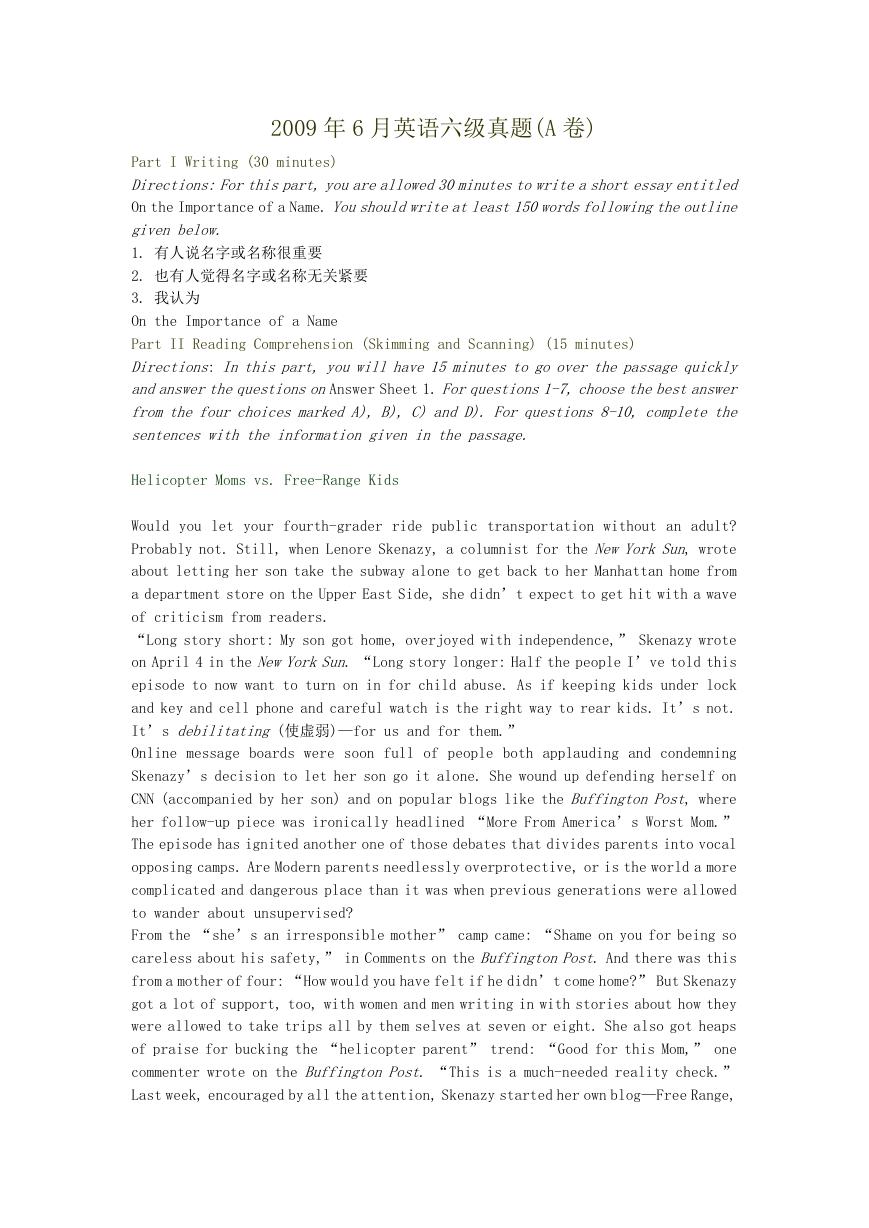
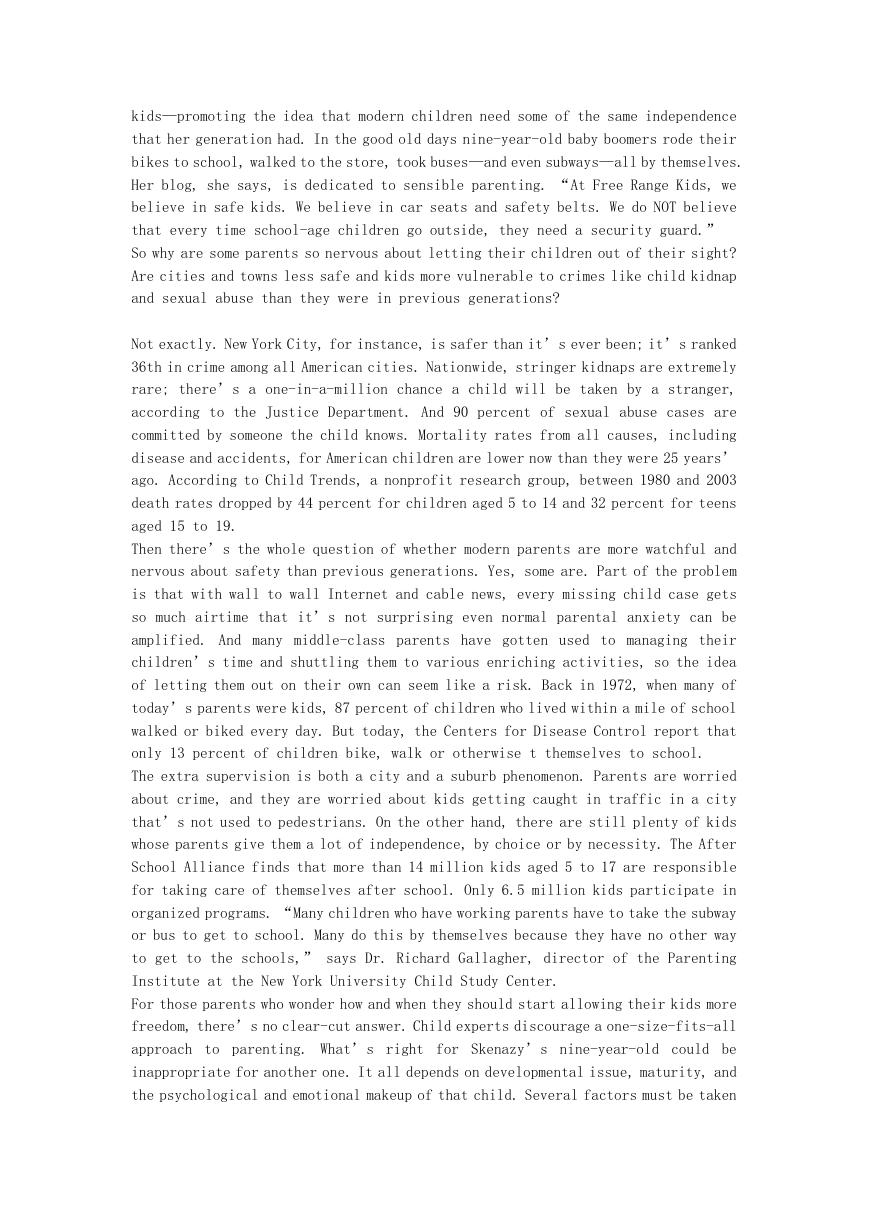
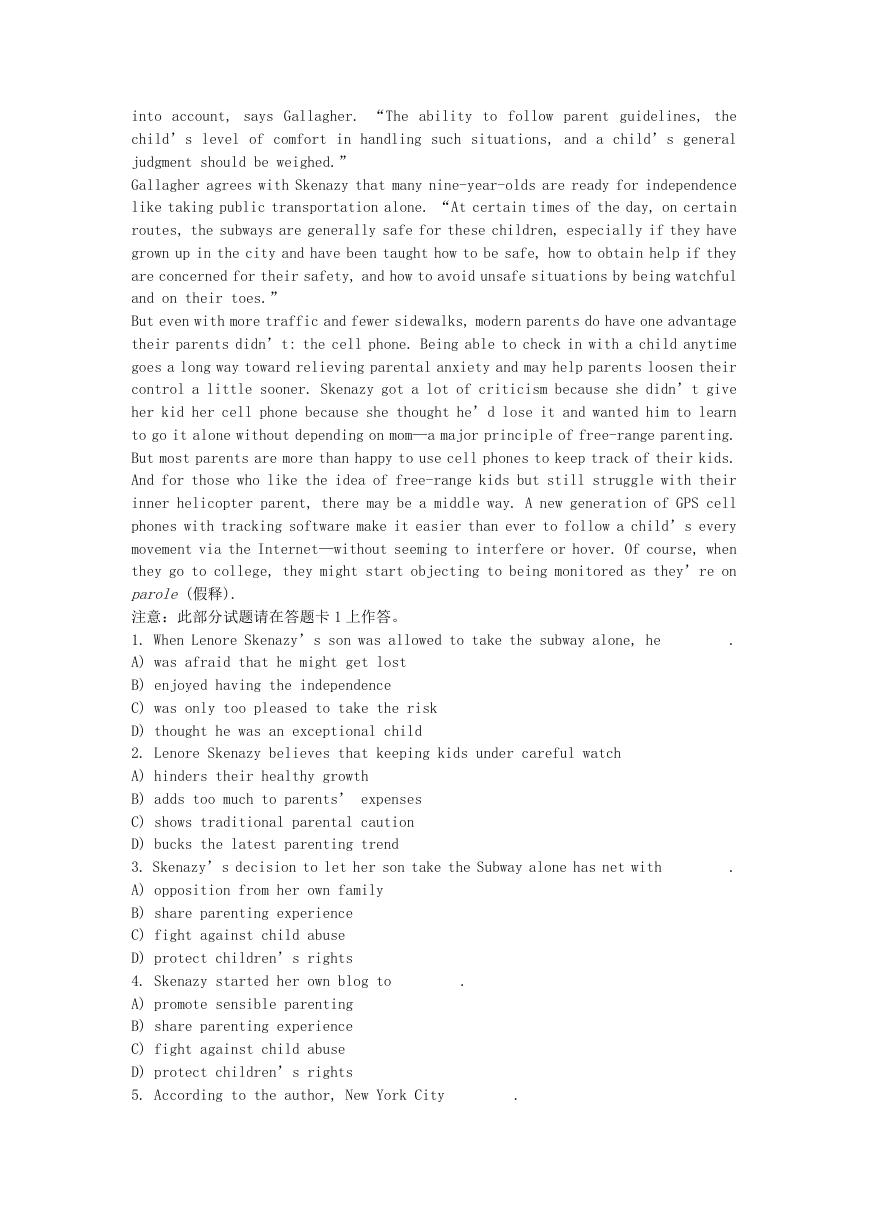
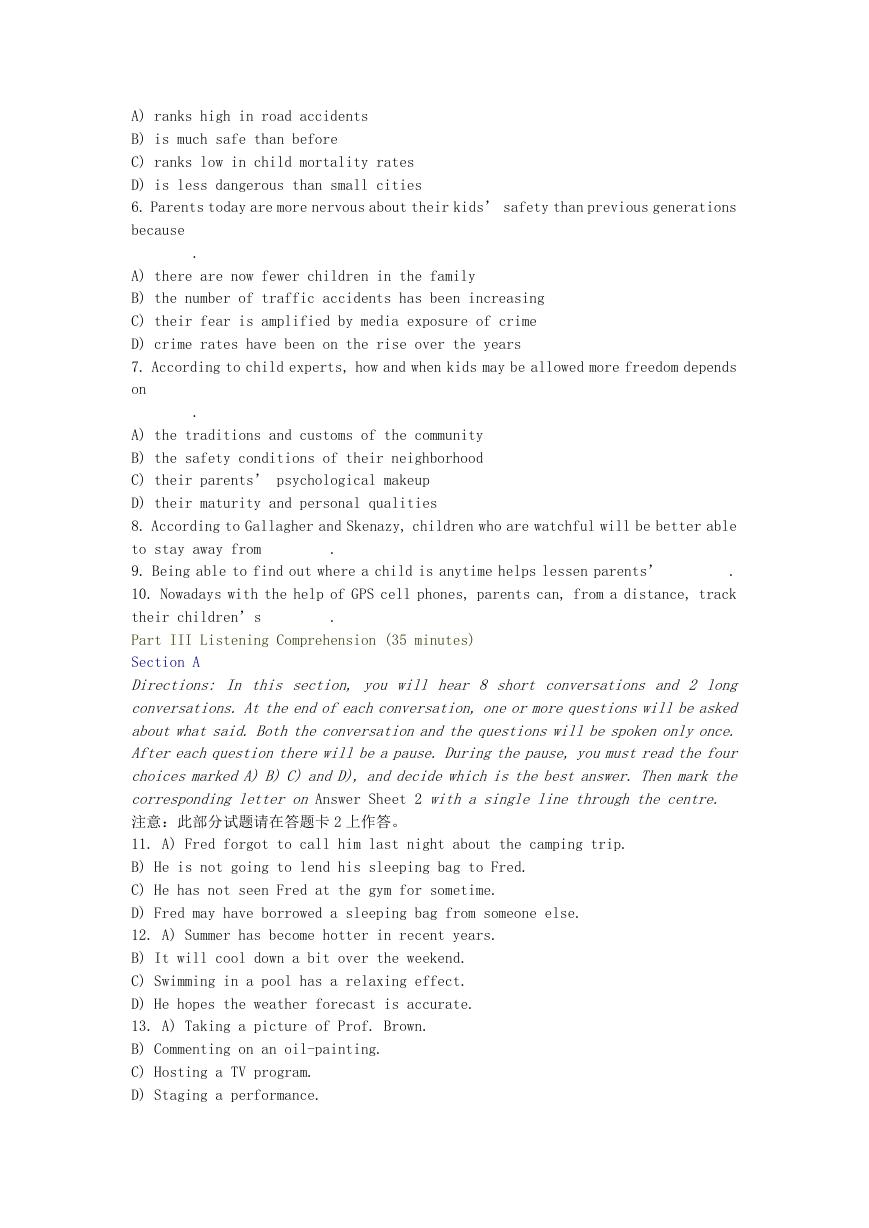
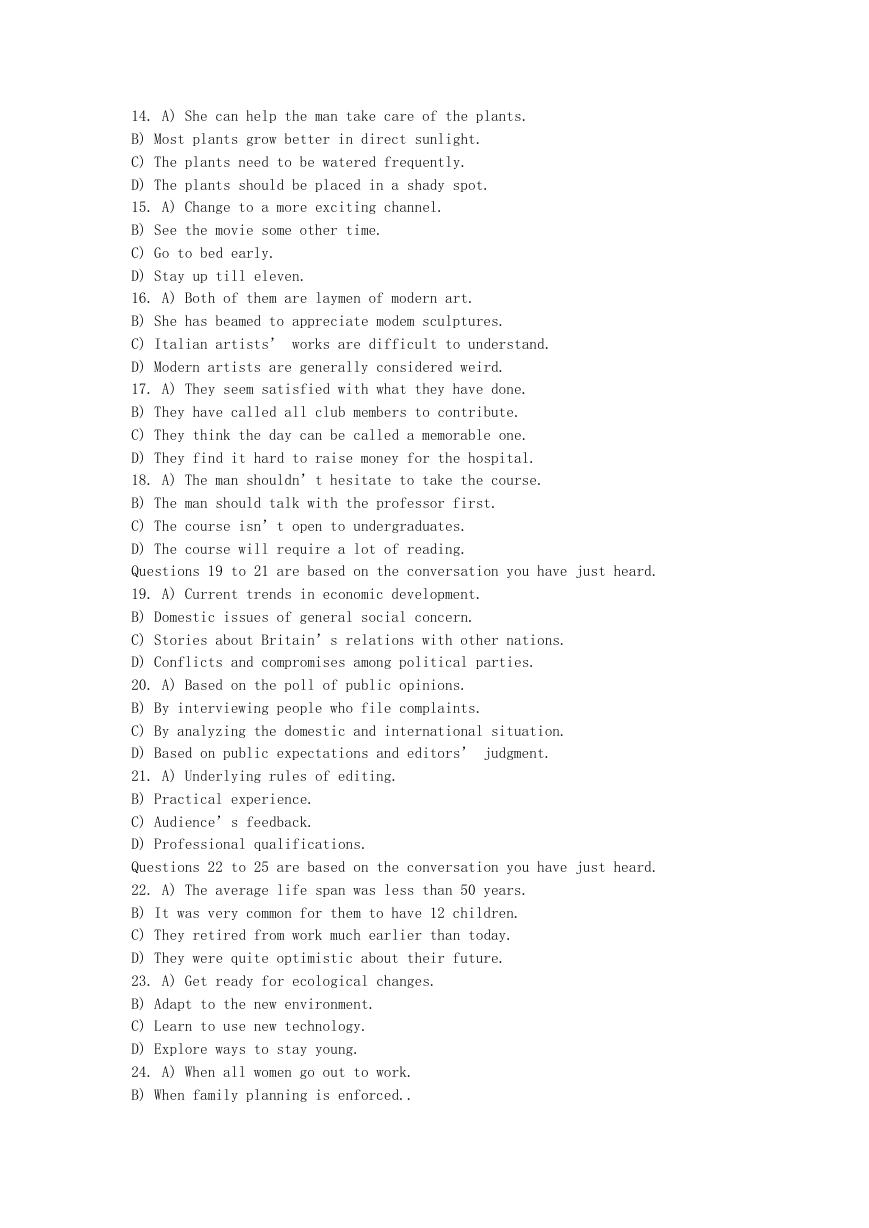
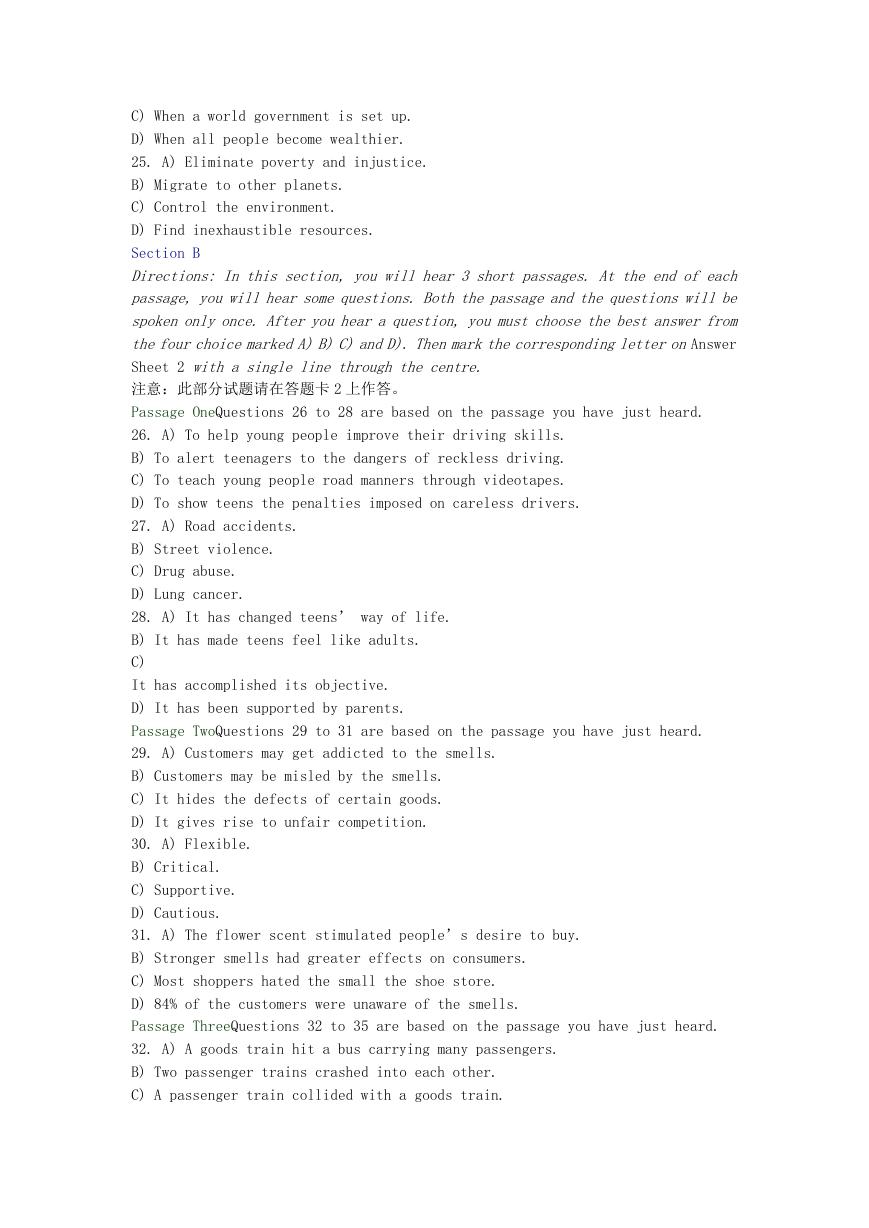
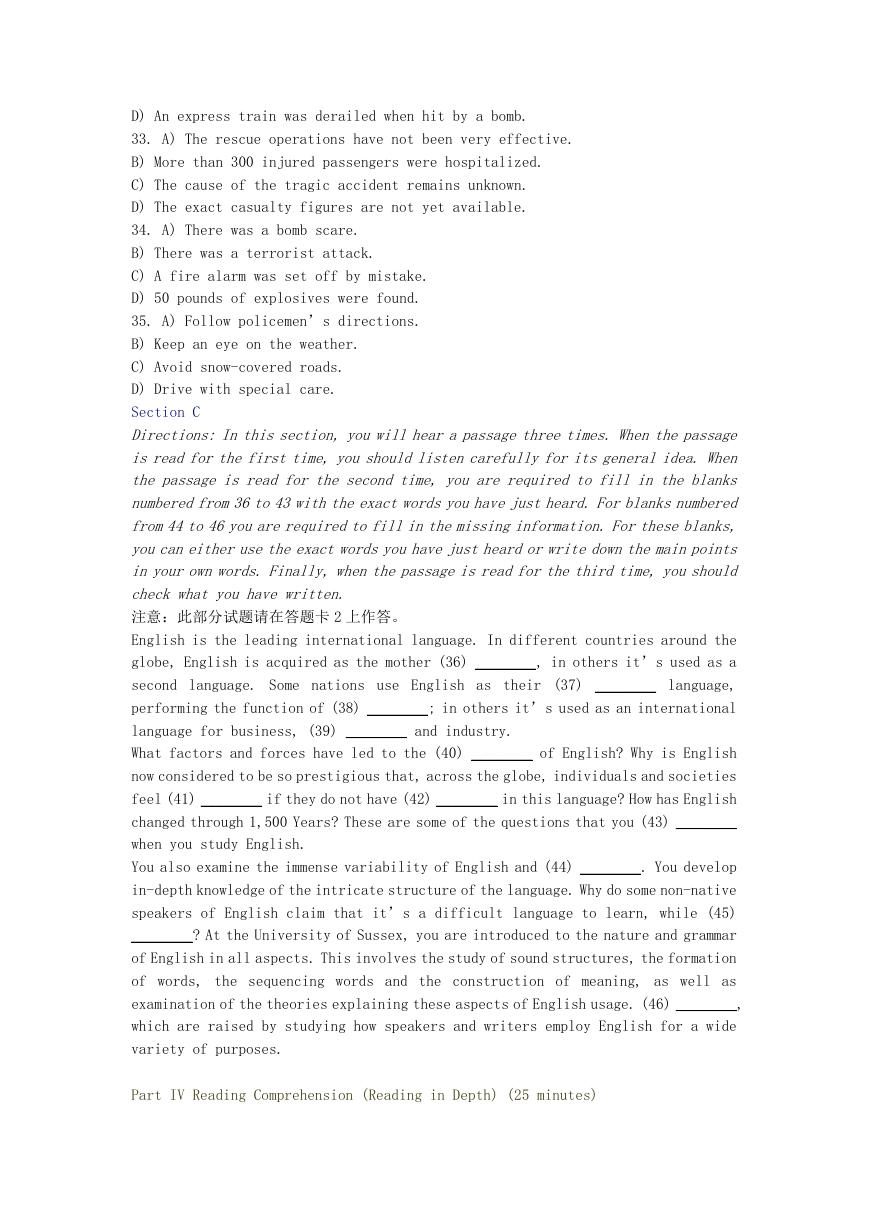
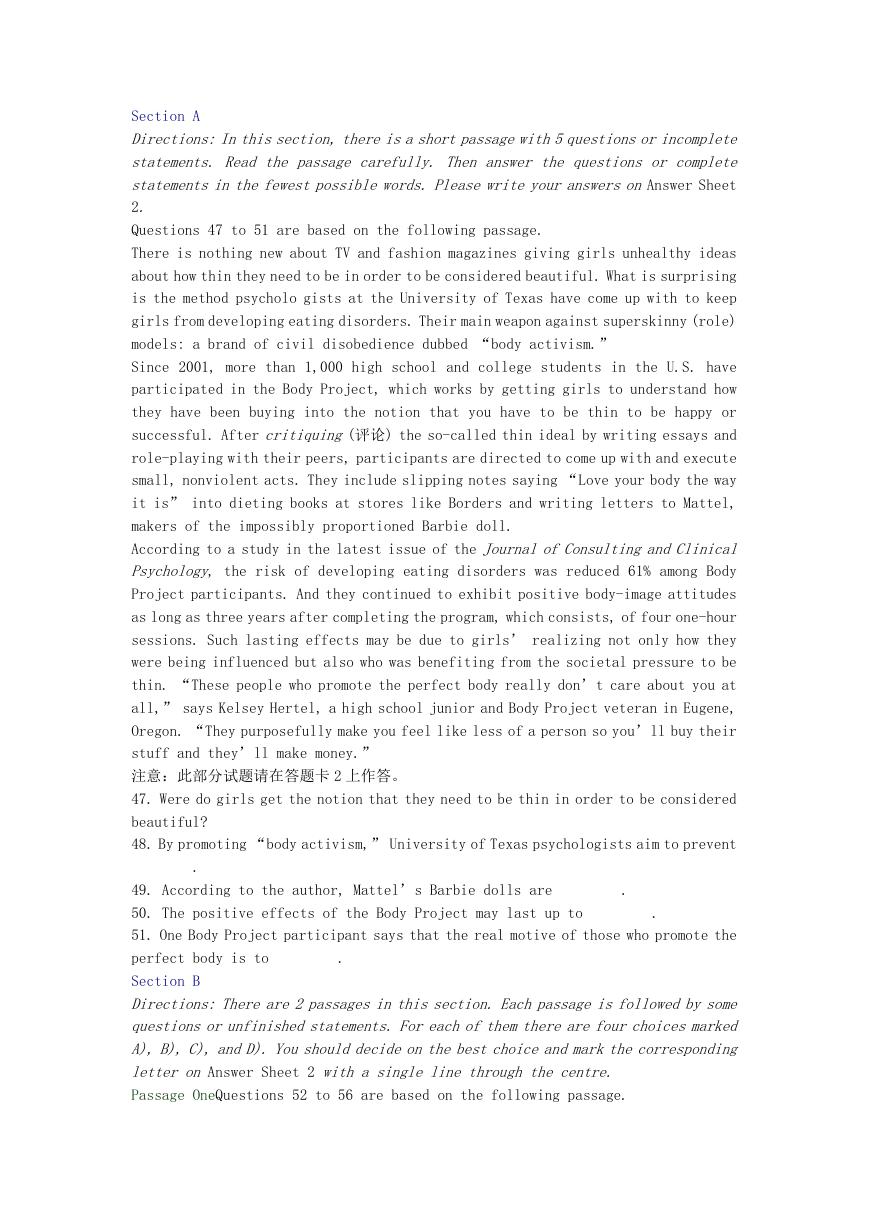








 2023年江西萍乡中考道德与法治真题及答案.doc
2023年江西萍乡中考道德与法治真题及答案.doc 2012年重庆南川中考生物真题及答案.doc
2012年重庆南川中考生物真题及答案.doc 2013年江西师范大学地理学综合及文艺理论基础考研真题.doc
2013年江西师范大学地理学综合及文艺理论基础考研真题.doc 2020年四川甘孜小升初语文真题及答案I卷.doc
2020年四川甘孜小升初语文真题及答案I卷.doc 2020年注册岩土工程师专业基础考试真题及答案.doc
2020年注册岩土工程师专业基础考试真题及答案.doc 2023-2024学年福建省厦门市九年级上学期数学月考试题及答案.doc
2023-2024学年福建省厦门市九年级上学期数学月考试题及答案.doc 2021-2022学年辽宁省沈阳市大东区九年级上学期语文期末试题及答案.doc
2021-2022学年辽宁省沈阳市大东区九年级上学期语文期末试题及答案.doc 2022-2023学年北京东城区初三第一学期物理期末试卷及答案.doc
2022-2023学年北京东城区初三第一学期物理期末试卷及答案.doc 2018上半年江西教师资格初中地理学科知识与教学能力真题及答案.doc
2018上半年江西教师资格初中地理学科知识与教学能力真题及答案.doc 2012年河北国家公务员申论考试真题及答案-省级.doc
2012年河北国家公务员申论考试真题及答案-省级.doc 2020-2021学年江苏省扬州市江都区邵樊片九年级上学期数学第一次质量检测试题及答案.doc
2020-2021学年江苏省扬州市江都区邵樊片九年级上学期数学第一次质量检测试题及答案.doc 2022下半年黑龙江教师资格证中学综合素质真题及答案.doc
2022下半年黑龙江教师资格证中学综合素质真题及答案.doc